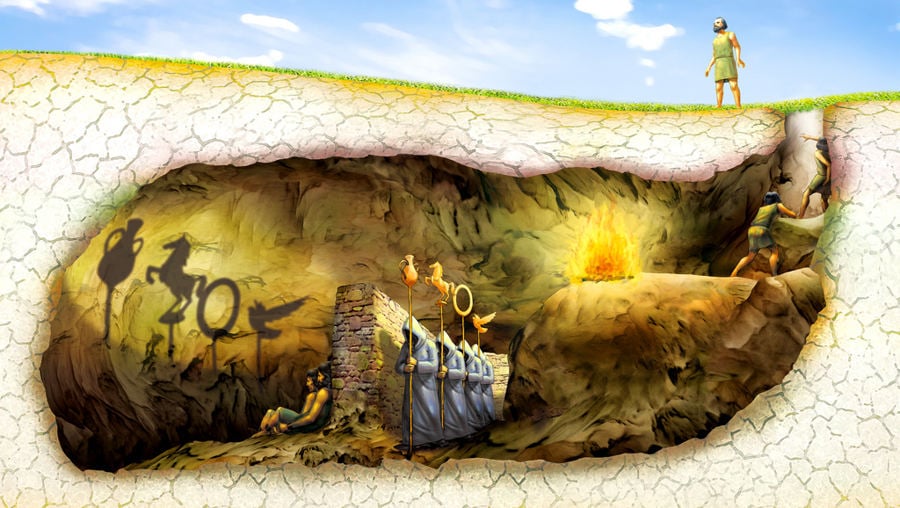
Keywords: Literature and philosophy theory of forms knowledge in fiction Plato J.R.R. The questions pondered in this article rise from the overall problems of the metaphysical structure of Tolkien’s fantasy universe as well as its epistemic laws as represented by the symbol of the cave. This article is centred around the cave-thematic, but also takes into account the motifs of light, seeing, and blindness that are very common in Tolkien’s fiction: the preliminary assumption is that light and darkness have great epistemic value in Tolkien’s fiction not only symbolically but literally, and Plato’s Analogy of the Sun will be used to illustrate and justify this reading. The analysis focuses on the characters of Gollum and Bilbo and considers the moments of entering and leaving the subterranean cave as a transition between different metaphysical and epistemic positions.


The Allegory of the Cave will be examined alongside the Analogy of the Sun in a manner that takes into account both their literal and analogous aspects, and The Republic will be seen not only as a theoretical work of philosophy but as an eloquent literary dialogue as well. Plato’s metaphysical and epistemological views, known as the theory of forms, provide the theoretical foundation for the analysis in which the literal and figurative meanings of the cave motif are of primary interest. Tolkien’s The Hobbit and Plato’s Allegory of the Cave that appears in The Republic. Tolkien’s “Riddles in the Dark”Ībstract: This article presents a parallel reading of the chapter “Riddles in the Dark” from J.R.R. Peer-Reviewed Article Katariina Kärkelä Enlightening the Cave: Gollum’s Cave as a Threshold between Worlds in J.R.R. This is an important point to make because it establishes a critical link between the conventional academic career dichotomy of “academia” or “industry” where young scientists can flourish.Fafnir – Nordic Journal of Science Fiction and Fantasy Research, Volume 6, Issue 1, pages 99–109. Those living in the larger world know nothing of the cave, and while the freed may not always be the most knowledgeable, charismatic, or eloquent, who better suited to speak of its reality? The knowledge of abstract things is no less valuable than the world of forms, and scientists who can bridge this gap must do so. Plato would have the freed return to the cave, but communication of knowledge goes both ways. He is then able to behold the sun and deduces that it is the “…source of the seasons and the years, and is the steward of all things in the visible place, and is in a certain way the cause of all those things he and his companions had been seeing.” He is then able to look at the stars and moon by night and finally he is able to look upon the sun. Next he can see the reflections of things in water and later is able to see things themselves. He is first able to see only shadows of things. “Slowly, his eyes adjust to the light of the sun. Plato’s freed are dragged in pain and irritation up and out of the cave, whereupon the discomfort only intensifies as the radiant light of the sun overwhelms the eyes. Like Plato’s freed, scientists who ultimately leave the lab to see the world outside inevitably begin to question their previous beliefs. This is part of why, in spite of the push for more ‘engagement’ with publics beyond academe, these activities are not professionally recognised in the same way as more traditional activities like peer-reviewed publications.” This was described best by Melonie Fullick, a fellow blogger in her article “ ‘Public Intellectuals’ A Losing Game.” Here she laments that knowledge dissemination to non-specialist audiences “means ‘dumbing down’ one’s message. While Plato argues that only those who have ascended to the highest level of knowledge (whom he calls philosopher kings), must then return to share in their labours with the masses, I believe that public intellectuals, regardless of academic standing, should become the rule, not the exception.Īcademic culture, far from promoting new perspectives, implicitly encourages a low regard for those who work in the “public” eye. It is only by leaving the cave that I have come to understand that the shadows on the wall do not make up reality at all. Plato’s Allegory of the Cave is therefore a fitting analogy, and as a young academic scientist I have often felt that I was facing a blank wall where shadows of things passing in front of a fire behind me were projected. Today’s young academic scientists are trapped in the lab, which is not so different from a cave.


 0 kommentar(er)
0 kommentar(er)
